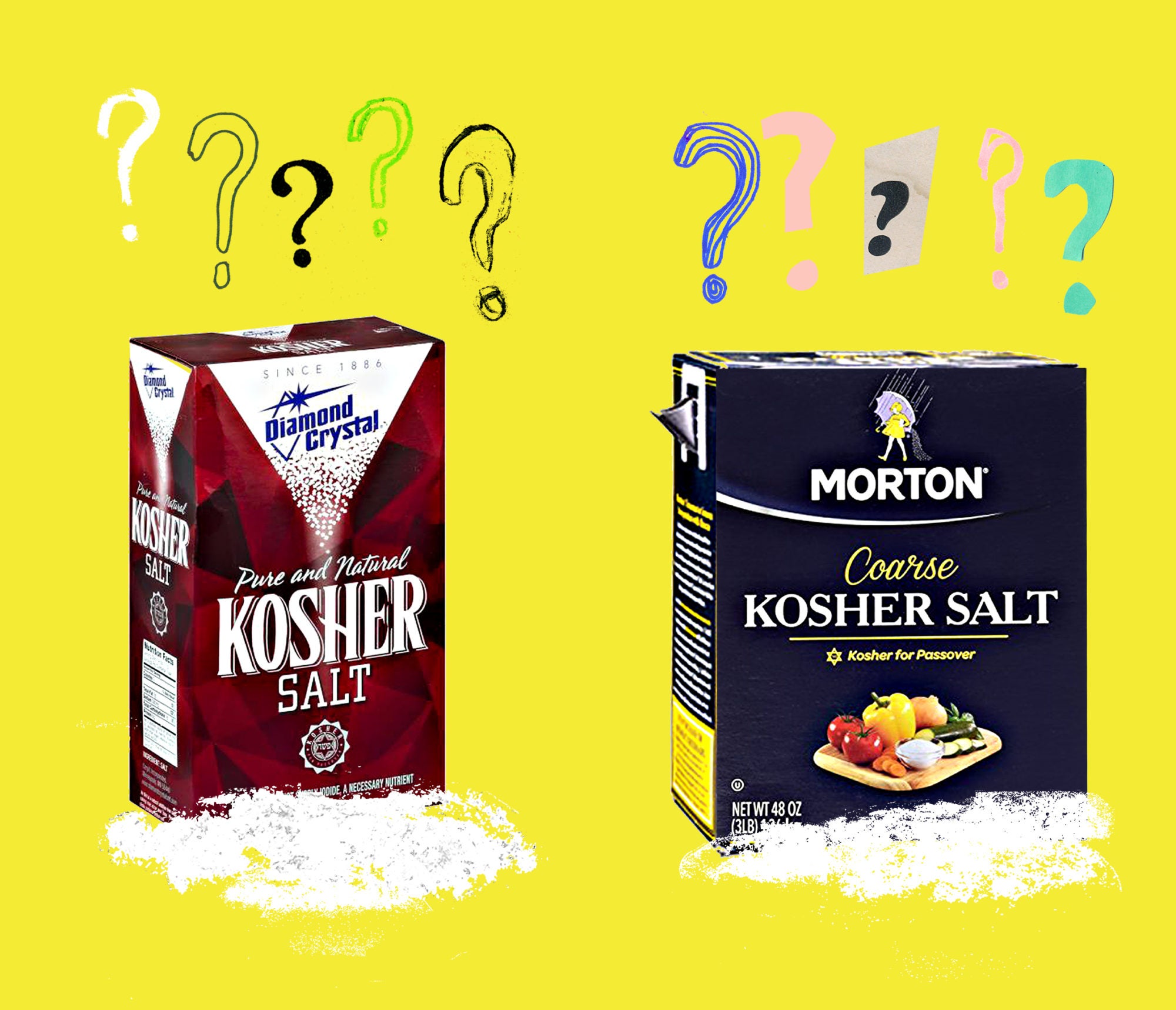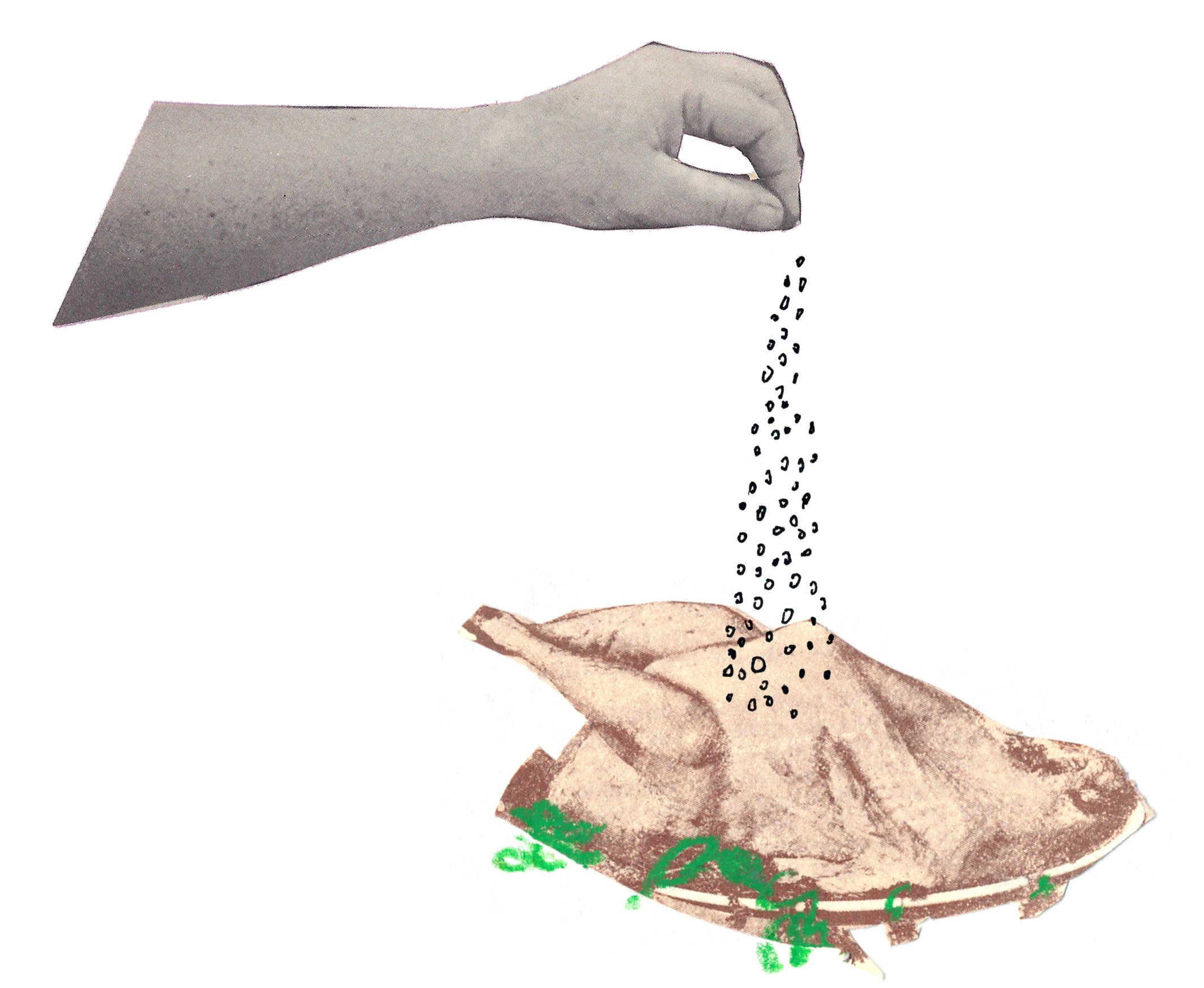
Prized for its purity and flaky texture, kosher salt has been a home-cooking standard for decades. But the two major brands, Diamond Crystal and Morton, are very different products. Your ruined meatballs can attest.
Cooking magazine editors are no strangers to the complaints department. Frequently, readers make liberal substitutions or skip over steps in recipes. “I cut half the sugar, replaced the white flour with rye, and only used egg whites. This cake was terrible. VERY DISAPPOINTED.” But when complaints started rolling in for one Bon Appétit magazine recipe, the editors paid attention. The dish in question was on the cover of their January 2013 issue: a fat, brined pork chop dramatically set in a black cast-iron plan—its thick, caramelized crust the tone of chestnut. Foaming butter, browning in swirls with a sprig of singed thyme and few bulbs of golden garlic, surrounded it. You wanted to cook it right away.
“We got letters from readers saying, ‘We followed it to the letter and it came out inedibly salty,’” says Carla Lalli Music, Bon Appetit’s food director. “When we hear the same thing from several people, we take that very seriously.” In a double misfortune, this cover recipe was also in the Cooking School issue, which promised to teach readers how to do the basics flawlessly. While many food publications have cut staff in recent years, paring down their recipe development, Bon Appétit puts every recipe through a rigorous process, with multiple tastings and tweakings before it is “cross-tested”—made by a different recipe editor, one who had nothing to do with creating it—to make absolutely sure that it works. The pork chop recipe, like every other recipe, had been put through the wringer. What had happened?
If you’ve cooked out of a book, magazine, or newspaper in the past three decades or so, chances are pretty good that many of the recipes you’ve used have called for kosher salt. It’s been an American standard for a good while. The trouble is that the two major kosher salt brands—Diamond Crystal and Morton—perform in wildly different ways. Diamond Crystal was the salt that Bon Appétit used in its test kitchen. After a brief investigation, the editors found out that some of the readers with salty pork chops had used Morton, and others had used regular table salt. Lalli Music swiftly put out a directive to the test kitchen team that from then on, recipes would be cross-tested with Morton salt, and recipes for both brands of kosher salt starting showing up in the magazine’s pages soon after.
All salt is the same ingredient: NaCl, or sodium chloride. But a cup of Morton is nearly twice as salty as Diamond Crystal. Its thin crystals, made by pressing salt granules in high-pressurized rollers, are much denser than those of Diamond Crystal, which uses a patented pan-evaporation process, called the Alberger method, that results in pyramidal crystals. While different brands of fine sea salts and table salts generally have around the same weight by volume, kosher salts do not. “And it’s not only the weight,” says Lalli Music. “Morton is a coarser salt. It takes a little longer to dissolve.” So even at the same weight, it actually performs differently. It’s easier to add too much of the slow-dissolving Morton salt because it may not have fully liquefied when you’ve tasted something.

That kosher salt is even the standard for recipes is something of an American peculiarity, and like Fahrenheit and inches, we’ve clung to it despite its inconveniences. In the late 1800s, American salt companies started targeting the Jewish community with “koshering salt,” a coarser-grained variety good for removing the blood from meat and thus the kind of salt you would use for “koshering” meat. The name was later shortened to “kosher salt,” something of a misnomer given that it’s defined by its texture, not rabbinical oversight, and it was marketed to the wider public in the 1960s. American chefs soon adopted the stuff, prizing its purity and flaky texture in contrast to other varieties, like table salt, which often has added iodide or anti-caking agents to prevent clumping.
“Kosher salt is the restaurant standard for when you’re using your fingers to sprinkle,” says New York Times dining columnist Melissa Clark, the author of many cookbooks, including, most recently, Dinner: Changing the Game. “The large grains fall easily on a piece of meat, and chefs get to know how much their pinch encompasses. So they can season by feel rather than measuring. And it’s cheap.” The restaurant standard was soon adopted by cookbooks, magazines, and newspapers. Clark, like the editors at Bon Appétit, uses Diamond Crystal, as does Samin Nosrat, who just published her first cookbook, the excellent Salt Fat Acid Heat. “I learned to cook at Chez Panisse, and we mostly used Diamond Crystal,” says Nosrat. “At some point, we switched to sea salt and everything became super salty. It took chefs a while to adjust.” Even professionals can get thrown off when the salt is different.
“The mind-set one enters with Diamond Crystal is ‘Oh, I can use a lot of this and an extra bit won’t make a difference,’” Nosrat says. “You don’t have that freedom with other salts. I like that freedom.” But for her cooking column in The New York Times, she calls for sea salt. Why? For one recipe, a copy editor at the Times removed the brand name of Diamond Crystal in the line that called for kosher salt. So to avoid angry reader mail, Nosrat switched to sea salt. (She wasn’t aware of Bon Appétit’s incident.) A while back, her friend, Jill Sanpietro, Chowhound’s food editor, tested a recipe for chocolate chip cookies she had tested 20 times, but still got an irate letter from a reader saying the cookies were so salty that she couldn’t serve them. The difference between Diamond Crystal and Morton, of course, was the discrepancy. “That haunted me,” said Nosrat.
All salt is the same ingredient: NaCl, or sodium chloride. But a cup of Morton is nearly twice as salty as Diamond Crystal.
Kosher salt never quite made it to Europe or Asia, where sea salt is more prevalent. For the publishing of Nosrat’s book in the U.K., her publisher has told her that they’ll have to substitute for Diamond Crystal, which is not widely available there. Cookbook author and baking expert Dorie Greenspan, who started out using the salt she grew up with, Diamond Crystal, earlier in her career, now uses fine sea salt and fleur de sel. She made the change when she started working with French chefs and wanted to better translate their cooking into recipes, and stuck with it because she came to prefer the flavor—and consistency across brands. American bakers mostly stay away from kosher salt, too. “Fine sea salt is better for baking and dissolves really quickly in liquids,” says Clark. “And it’s more consistent for measuring.” That’s why bakers, like food scientist Shirley Corriher, author of Bakewise, and Rose Beranbaum Levy, author of The Cake Bible, call for sea salt or fine salt.
The editors at Bon Appétit had known for some time that there were differences between the two brands. They published an article in 2008 on the discrepancies. The New York Times also came out with its own article, “Warning: Measure Your Salt,” in 2010. And other cooking sites, like Food52 and Smitten Kitchen, have published their own missives. Serious Eats has taken the step of specifically calling for Diamond Crystal in its recipes for which measuring salt makes a difference. Yet for all that has been written on the two kosher salts, the information hasn’t filtered down to the cooking public.
And in many recipes, it doesn’t affect things too much, so readers can blissfully use their Morton salt in recipes tested with Diamond Crystal without anything going wrong. “Sometimes we’ll cross-test a recipe, and we’ll find it’s negligible,” says Lalli Music. Some recipes suggest salting to taste, and in others the amount is small enough that the final product isn’t noticeably different. But in cases where you can’t season to taste, like baked goods, sausages, cured fish, meatballs, pickles, and brined meats, and there is a noticeable difference, Bon Appétit took the extraordinary step of publishing two salt measurements, like a zucchini scone recipe this year that called for either one tablespoon of Diamond Crystal or one and a half teaspoons of Morton. Right now, only Serious Eats and Bon Appétit specify the kosher salt brand, and only Bon Appétit offers two measurements. But that may change. All it takes is a few angry reader e-mails to scare an editor straight.